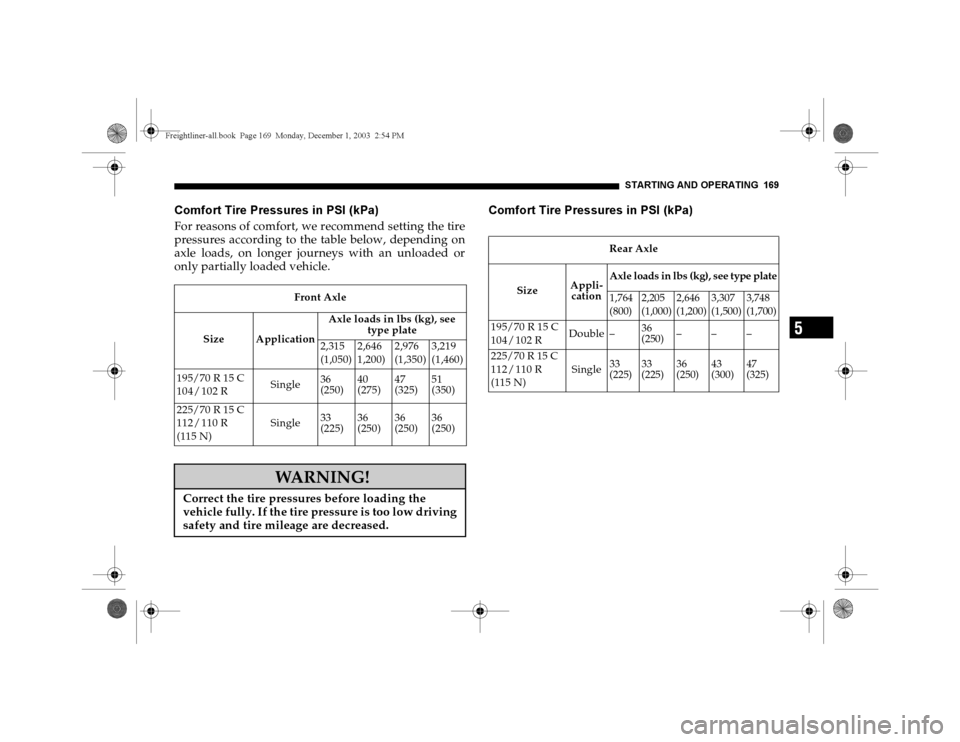Page 167 of 272
STARTING AND OPERATING 167
5
Tire Pressures of Loaded Vehicle in PSI (kPa)
Front Axle
Size ApplicationAxle loads in lbs (kg), see type plate
2,976
(1,350)3,219
(1,460)3,527
(1,600)3,638
(1,650)3,858
(1,750)
195/70 R 15 C 104 / 102 R Single 47 (325) 51 (350) – 58 (400) 65 (450)
225/70 R 15 C 112 / 110 R
(115 N)Single 36 (250) 36 (250) 40 (275) – 51 (350)
LT 225 / 75 R 16 115 N Single 55 (380)
Freightliner-all.book Pag e 167 Monday, December 1, 2003 2:54 PM
Page 168 of 272
168 STARTING AND OPERATINGTire Pressures of Loaded Vehicle in PSI (kPa)
Rear Axle
Size ApplicationAxle loads in lbs (kg), see type plate
5,070
(2,300)6,172
(2,800)6,613
(3,000)7,054
(3,200)
195/70 R 15 C 104 / 102 R Double 40 (275) 51 (350) 55 (380) 65 (450)Rear Axle
Size ApplicationAxle loads in lbs (kg), see type plate
3,307
(1,500)3,748
(1,700)3,968
(1,800)4,409
(2,000)4,938
(2,240)5,357
(2,430)
225/70 R 15 C 112 / 110 R
(115 N)Single 43 (300) 47 (325) 51 (350) 58 (400) 65 (450) 70 (480)
LT 225 / 75
R 16 115 NSingle 80 (550)
Freightliner-all.book Pag e 168 Monday, December 1, 2003 2:54 PM
Page 169 of 272

STARTING AND OPERATING 169
5
Comfort Tire Pressures in PSI (kPa)For reasons of comfort, we recommend setting the tire
pressures according to the table below, depending on
axle loads, on longer journeys with an unloaded or
only partially loaded vehicle.
Comfort Tire Pressures in PSI (kPa)
Front Axle
Size ApplicationAxle loads in lbs (kg), see
type plate
2,315
(1,050)2,646
1,200)2,976
(1,350)3,219
(1,460)
195/70 R 15 C
104 / 102 R Single36
(250)40
(275)47
(325)51
(350)
225/70 R 15 C
112 / 110 R
(115 N)Single33
(225)36
(250)36
(250)36
(250)
WARNING!
Correct the tire pressures before loading the
vehicle fully. If the tire pressure is too low driving
safety and tire mileage are decreased.
Rear Axle
SizeAppli-
cationAxle loads in lbs (kg), see type plate1,764
(800)2,205
(1,000)2,646
(1,200)3,307
(1,500)3,748
(1,700)
195/70 R 15 C
104 / 102 RDouble
–36
(250)–––
225/70 R 15 C
112 / 110 R
(115 N)Single
33
(225)33
(225)36
(250)43
(300)47
(325)
Freightliner-all.book Pag e 169 Monday, December 1, 2003 2:54 PM
Page 197 of 272

WHAT TO DO IN EMERGENCIES 197
6
Centering wheels with wheel bolts
If dual assemblies are used, before placement the
inner wheel should be inspected to ensure that all
ball bearing rings are in proper position.
Install the wheel and snug the wheel bolts.
Slightly tighten wheel bolts.
Slowly open jack release valve to lower vehicle until
tire is resting on ground.
Tighten the wheel bolts in a crosswise pattern to the
specified torque with a torque wrench.
Tightening torque for 8,550 lbs (3,880 kgs)
(vehicle type 2500 C/HC/SHC):
Steel wheel – 177 lbf.ft ±7 lbf.ft (240 N.m ±10 N.m)
Light alloy wheel – 138 lbf.ft ±14 lbf.ft
(190 N.m ±20 N.m)
WARNING!
Incorrect mounting bolts or improperly tightened
mounting bolts can cause the wheel to come off.
To avoid the risk of serious or fatal injuries or ve-
hicle damage, please bear the following points in
mind:• Always replace wheel bolts that are damaged or
rusted.• Never apply oil or grease to wheel bolts• If a wheel hub thread is damaged, you must not
drive the vehicle. Consult a qualified specialist
workshop.
WARNING!
Do not tighten the wheel bolts and wheel nuts
completely while the vehicle is still jacked up.
The vehicle could tip.
Freightliner-all.book Pag e 197 Monday, December 1, 2003 2:54 PM
Page 198 of 272

198 WHAT TO DO IN EMERGENCIES
Tightening torque for 9,990 lbs (4,530 kgs)
(vehicle type 3500 C/HC/SHC):
Steel wheel – 138 lbf.ft ±14 lbf.ft (190 N.m ±20 N.m)
Remove jack and stow it in the vehicle tool kit.
Check the tire pressure.
Re-tighten the wheel bolts to the specified torque
with a torque wrench after a distance of 30 miles
(about 50 km).
JUMP STA RTINGIf the battery is dead, the engine can be started with
jumper cables from another vehicle’s battery.
WARNING!
After changing a wheel, you must, for safety reasons,
have the specified tightening torque checked. The
wheels could otherwise work loose.
check the tire pressure and correct it if necessary.
retighten the wheel bolts and wheel nuts to the
specified tightening torque once the vehicle has
been driven for 30 miles (50 km).
have a reversed direction of tire rotation corrected
as soon as possible at a qualified specialist
workshop. The vehicle handling characteristics
could otherwise be affected.
WARNING!
A battery will also produce hydrogen gas, which
is flammable and very explosive. Avoid open
flames and the formation of sparks in the vicinity
of the batteries. Refrain from smoking or cell
phone use. Avoid improper connection of jumper
cables.
Observe safety precautions when handling
batteries.
Exercise care near moving engine components and
electrical cables.
Failure to follow these directions will cause
damage to the electronic components and can lead
to a battery explosion and severe injury or death.
Freightliner-all.book Pag e 198 Monday, December 1, 2003 2:54 PM